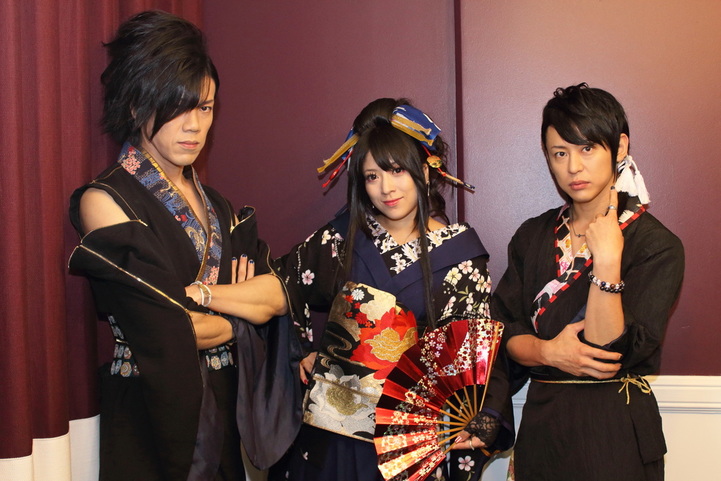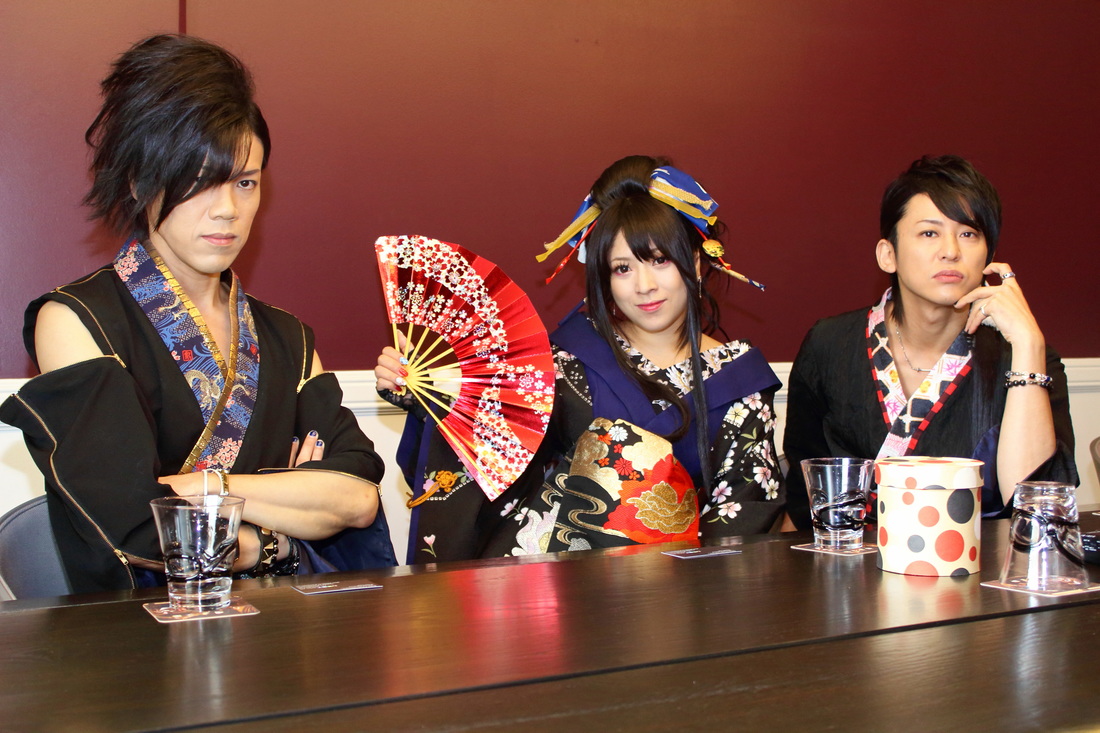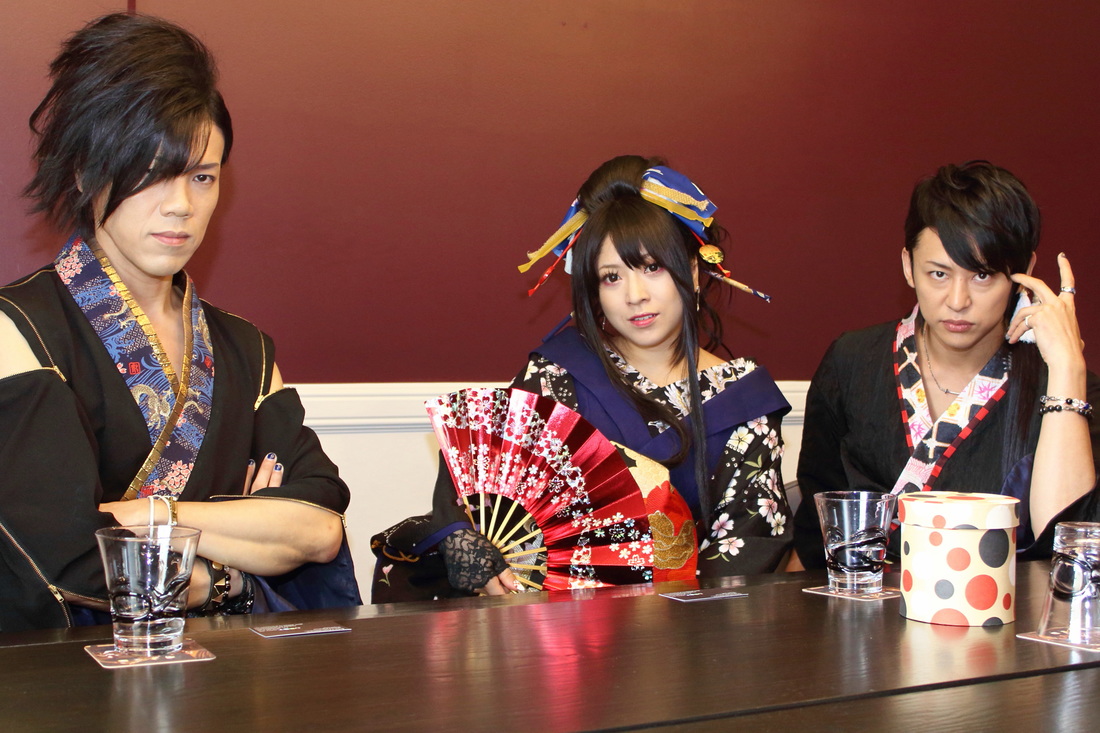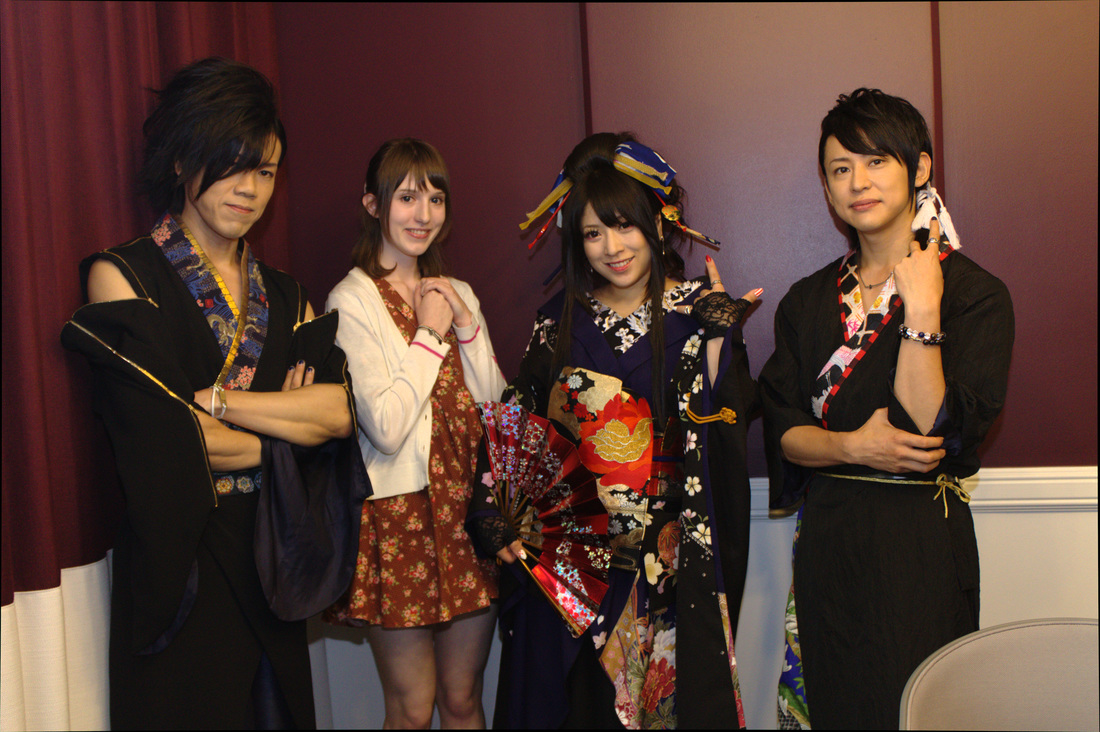|
We at A-To-J Connections had the wonderful opportunity to cover WagakkiBand’s DEEP IMPACT Tour in its entirety and were able to catch up to them prior to their San Francisco show for an interview! During the discussion it was clear that they were in the midst of a very special series of shows and that their show the following day was going to be one to remember! We at A-To-J Connections are big supporters of WagakkiBand and hope that our readers and fans will check out their amazing blend of rock and traditional Japanese music! We at A-To-J Connections had the wonderful opportunity to cover WagakkiBand’s DEEP IMPACT Tour in its entirety and were able to catch up to them prior to their San Francisco show for an interview! During the discussion it was clear that they were in the midst of a very special series of shows and that their show the following day was going to be one to remember! We at A-To-J Connections are big supporters of WagakkiBand and hope that our readers and fans will check out their amazing blend of rock and traditional Japanese music! A-To-J: Thank you for the interview, can you please introduce yourselves? Yuko: My name is Yuko Suzuhana, I’m the singer. Kurona: My name is Kurona, and I play the wadaiko (Japanese drums). Nice to meet you. Kiyoshi: I’m Kiyoshi Ibukuro, and I play the Koto. A-To-J: Can you tell us a bit about the formation of WagakkiBand and where you got the idea to fuse traditional Japanese music with a rock sound? Yuko: Since I was 5 years old, I’ve been practicing the traditional Japanese singing style of “Shigin.” The Koto and Shakuhachi are used as instrumental accompaniments when singing Shigin, so I’ve always felt attached to them. Wagakki (Japanese traditional instruments) instruments are not seen or used much in Japan nowadays. So as I lived my entire life surrounded by Wa music, I grew stronger feelings of wanting more people to become familiar with Wagakki instruments. So as I met other non-traditional musicians such as guitarists and bassists, I asked them if they wanted to try incorporating Wagakki instruments. We started having more and more music sessions, and we just meshed well together. That’s how we started as a band. A-To-J: What were some of the other musical projects you were part of before WagakkiBand and how were they different? Yuko: All of our members were in different bands originally. For my acoustic band, I sang while playing the piano, and had a Koto and Shakuhachi as accompanying instruments. But then we added… non-acoustic instruments? So we had trouble keeping rhythm. We had trouble balancing the sound levels as well. As WagakkiBand, we’re very expressive, and the instruments often clash with each other. The mid-range sounds are clumped up, so it can be difficult to balance it so that all the sounds can be picked up. So we worked hard on overcoming those problems through experimenting and improvising. I think that was the biggest difference coming into WagakkiBand. Kurona: I used to play the Wadaiko in a heavy rock band while Kiyoshi played the bass guitar, and in another visual kei band I did vocals while he played the koto. We also had a more traditional music unit with the 3 of us, playing the Shakuhachi and Shamisen. We had a lot of different musical backgrounds. Yuko: My singing style changed a lot. Before, I would sing like I normally would – but then we decided to adopt the Shigin singing style. We did this because not only is it a more traditional singing style, but we felt like it just… worked well with our instruments. Kiyoshi: I feel like with our band, it’s very easy for us to materialize the kind of sound we want to create. For example, if we have an idea we want to try out - we can immediately say, “Let’s try this out with the guitar and taiko!” A lot of our members are always open to trying new things. Kurona: We’re not uptight about things – we won’t be saying things like “it has to be this way.” Our members are very receptive to these new, rich ideas A-To-J: Your first album was made up completely of vocaloid covers, was there a particular reason for this? Yuko: I mentioned this earlier, but even in Japan, traditional instruments aren’t very popular. When we were starting to have talks of creating this band, vocaloid was very popular. We thought it would be interesting to have people watch us on a video streaming platform (niconico). We wanted to upload something that would be well received by the younger generations – So we combined what we had with vocaloid, a culture very popular with young people. We thought this would gather interest from a lot of people, and decided to try it out. A-To-J: Your recent album "Yasou Emaki" on the other hand is mostly original songs, was there a focus to moving away from cover material? Kurona: One of the vocaloid songs that was popular on streaming websites had a lot of wagakki instrumentals – so we thought, “what if we performed these songs with real wagakki instruments?” And that’s how the album Vocalo Zanmai came to be. We then came together as a band, and the next step was to make our own music. The music of Yasoemaki was the result of what we wanted to express with our own hands. A-To-J: Do you think you will you look into covering more vocaloid songs in the future? Yuko: Currently we have no plans, but it’s not like we’re against the idea. If a song that we really want to cover comes up, we’ll definitely consider it. A-To-J: What are some of WagakkiBand’s musical inspirations? Kiyoshi: WagakkiBand is something that’s a first for us, so there aren’t any groups that are our role models. As individuals we have artists that we like of course. These artists influence our music compositions and arrangements. A-To-J: Can you tell us a bit about WagakkiBand's song-writing process? Yuko: We mentioned that we’ve been influenced by different artists. All of our band members are also a part of the song writing process. With our current style, we all bring together the music we have to offer from each of us, and then arrange them together into a song. For me personally, I’ve always worked with classical music, so a lot of my songs are ballads. I liked Disney music as a child, so Alan Menken is a big influence for me. For classical music, I’ve been influenced by Debussy and Chopin. As a female singer, I was influenced by Mariah Carey, so I tend to write songs that are pop or ballad. Kurona of course will have different kinds of songs to offer, with rhythms different from mine. Kurona: I’m influenced a lot by hard rock, and similarly intense kinds of music. So when I incorporate my rock background into Wagakki music, I think to myself, “How can I make this sound as cool as possible?” And that’s a process that’s very different between each band member. Yuko: That’s what keeps our band so fun and interesting. Kurona: When I’m writing a song’s melody, I think: “How can I write this song so that it’ll go well with Yuko’s singing?” When I’m writing for the Koto, I think: “How can I write this so that when Kiyoshi performs, it’ll sound cool?” That’s the kind of trusting relationship we have between band members, and it keeps us going. A-To-J: With so many great musicians and sounds within WagakkiBand, do you ever find it difficult to incorporate all the different elements into your music? Kiyoshi: When we want to create the music that we have in mind, it can be difficult to write the actual songs using pre-existing methods and techniques, due to the nature of our band. So in the song writing process, we have to come up with new ideas and techniques. For example, our guitarist might want develop a guitar with a longer fret board that can create new kinds of sounds. Or Kurona might want to develop new playing techniques or adopt new instruments. Kurona: Or the placement of the drums, for example. Kiyoshi: This process of coming up with new ideas is more fun than it is difficult, though. WagakkiBand - Strong Fate MV A-To-J: For many fans in the West WagakkiBand might be their first exposure to traditional Japanese instruments, what are your thoughts on being part of the spread of Japanese culture abroad? Yuko – I’m simply very happy about it. When we came here, we were surprised by the amount of interest everyone had for us. Japanese culture – not just traditional culture, but modern Japanese culture as well is spreading throughout the world right now, and I’m happy about that. We bring the “old” and the “new” parts of Japan together, and we hope that can bring people’s interests towards Japan. A-To-J: You've been to the US twice before and have completed two shows on this tour, what have you learned from these experiences? Yuko – I was very nervous at the New York show. Honestly, I was very worried at the time. New York is known as the center of entertainment, so I was troubled thinking, “what kind of performance would be most appreciated?” “Should I sing in English? Or in Japanese?” I worried a lot about these kinds of things. As we finished more and more concerts, we started gaining more confidence - we just needed to be ourselves. Even if they couldn’t understand the Japanese lyrics, singing in Japanese just worked better with the Shigin style of singing. So we just performed how we usually do, while hoping that people would be interested enough to want to look up the meanings of the lyrics. My worrying thoughts went away as we continued to perform. A lot of different aspects of our performance changed as well. Kurona: We noticed the crowds were very different from Japan as well. In Japan, fans in the crowd would often synchronize their motions with us. But outside of Japan, that wasn’t always the case, so we weren’t sure what the best way to do our performances was. But we settled with performing the same way we do in Japan. We hope that everyone can enjoy our concerts even more this way. A-To-J: What were your thoughts on the reactions you’ve received from your US fans? Yuko – We had heard that sometimes foreign crowds would just leave the concert if the performance wasn’t up to their expectations! But when we had our first concert, the crowd was really great, and would often sing in Japanese along with us. Between songs we would get a lot of replies in Japanese as well, and I really felt like I wanted to spend more time together with these fans. Every time we finish a concert, I find that I’m still learning new things about myself. U.S. concerts have really helped me grow as an artist, and I’d love to have more opportunities in the future. Kurona: I really like it when the crowd calls “WA - GA - KKI!” Yuko: Yeah, it makes me happy. Kurona: It gives me energy when fans know what Wagakki means and put so much positivity behind it. It really makes me happy that I can perform for them. Yuko: When I reach out towards Japanese crowds, they go “ahh (in awe)”, but with the American crowds, they go “ahh” coming at us! It’s really great. A-To-J: Have you had any time to do anything fun while you've been in the US during this visit? Yuko: We had a bit of time. Kiyoshi: We went cruising in San Diego. We traveled around in a boat. In LA, we didn’t have much time. Yuko: We all went somewhere though. Kiyoshi: We walked around the city, and… Kurona: We went to the observatory. Kiyoshi: We were thinking of going to the Golden Gate Bridge today. A-To-J: Can you share any funny stories that have happened while performing? Yuko: There’s a lot! Just for this US Tour? A-To-J: Any story is fine. Yuko: There’s many! Kiyoshi: There really is. Yuko: When Dai-San (Daisuke?) was beginning a performance with his Shakuhachi, the mic wasn’t working, so he just had this face – but the audience couldn’t hear him. Also… the guitarist and I would sometimes run into each other while performing. Kiyoshi: During a rehearsal, Yuko hit our Shakuhachi player with her umbrella. Yuko: It was an accident! Yuko: The koto is played by attaching 3 picks to your fingers, but once during a concert, the pick flew off into the crowd! Kurona: A lot happened yesterday. Kiyoshi: There was. Kurona: There was a part where the koto was supposed to start playing, but he didn’t hear the signal. So we had only the koto playing, and we weren’t sure what we should do. We all looked at each other’s faces – but then we came together and were able to recover. Yuko: I dropped my mic for the first time. I was performing a mai dance when I slammed it on the ground – everyone had to close their ears. I had to go grab it quickly and start singing again. A-To-J: What are some of your upcoming plans for WagakkiBand? Yuko: Upcoming plans… Oh! In the summer in Japan, there are these events called Natsu Fes. A lot of different artists come together for outdoor concerts, and WagakkiBand plans on attending a lot of these. Kurona: We’re releasing the single “Mi-ra-i” in August as a Rio Olympic Games tie-up song. It’s available for download and we’ll have a music video. A-To-J: Lastly, can you give a final message to your fans? Yuko: Personally, I really like America, and I’d love to live here one day. I’ve always admired America through watching Hollywood movies since I was a child, but this was actually my first time coming to America. It’s been a pleasant surprise being able to perform live in America, and we hope to be able to perform in all kinds of different places to show everyone what Japan is about. Coming to America has really opened my eyes on how different overseas can be. I have a much stronger desire now to experience and interact with these places – not just the West Coast like this tour, but we’d like people from all over the world to get to know us and Japan as a whole. A-To-J: Thank you for the interview! WagakkiBand Is: - Suzuhana Yuko (鈴華ゆう子) - Machiya (町屋) - Ninagawa Beni (蜷川べに) - Ibukuro Kiyoshi (いぶくろ聖志) - Asa (亜沙) - Kaminaga Daisuke (神永大輔) - Wasabi (山葵) - Kurona (黒流) For More Information: Official Site: wagakkiband.jp Official Facebook: facebook.com/WagakkiBand Official Twitter: @WagakkiBand Official Instagram: instagram.com/wagakkiband Official Fanclub: global-fc.net/wgb mu-mo Shop Listing: global-fc.net/wgb On iTunes (USA): itunes.apple.com/us/album/ba-zou-hui-juan/id1031872724 The above interview was conducted by Manuel Figueroa and Heidi Alford who also provided on-site translation with assistance by Kelsey Lightfoot. Post translation provided by Ryosuke Takeuchi You can watch the interview in full below! Interview with WagakkiBand
0 Comments
Leave a Reply. |
Search
Contributors◆ Emily
◆ Hinacchi ◆ Janette ◆ Manuel ◆ Megan ◆ Molly ◆ Rose ◆ Sylvia ◆ Teepu ◆ Tiffany Support Us On Patreon!Archives
July 2025
|
© 2014-2025 A-to-J Connections. All Rights Reserved.






 RSS Feed
RSS Feed